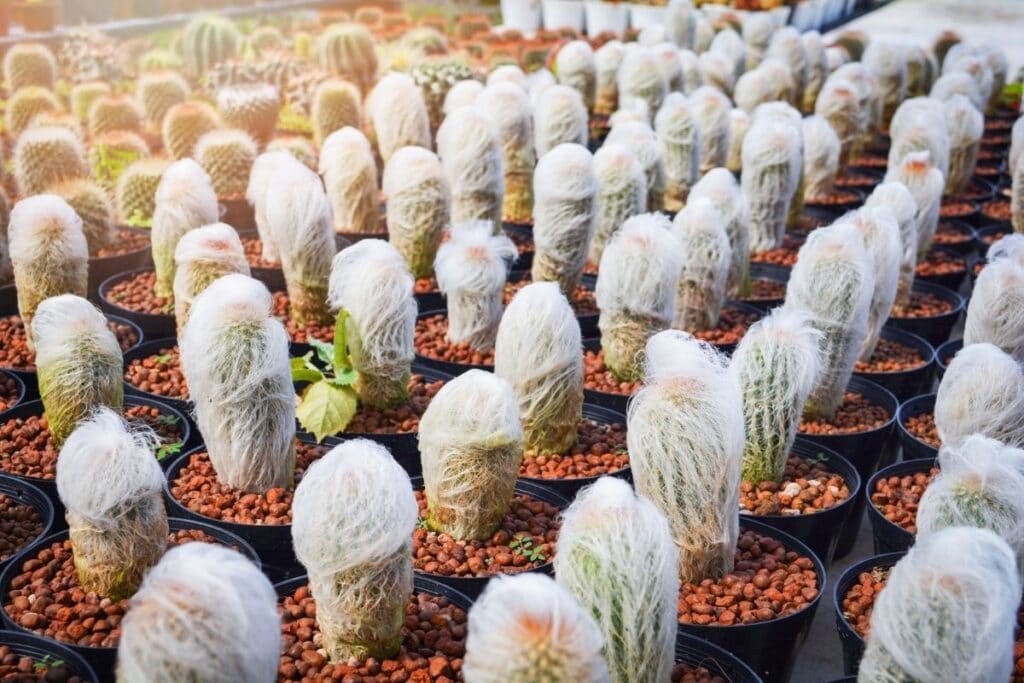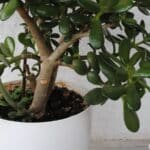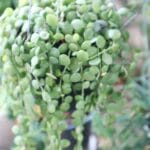Spines are some of the identifying features of cactuses. They usually appear as pointed protuberances covering the body of the cactus, making the plant look intimidating, albeit characteristically fascinating.
However, not all cacti are covered in prickly spines. Some species have a less threatening appearance like the Old Man Cactus. The unique morphology of its spines makes the cactus plant as charming as an old man’s wispy mane.
If you’re planning to include this cactus in your cactus collection, here is some information to get to know your Old Man cactus and how to grow and care for it.
What is Cephalocereus senilis?
Belonging to the family, Cactaceae, the Cephalocereus senilis is characterized by a fleshy columnar green to bluish green body slowly growing up to 15m high in its natural environment. Because of the weight of the ribbed stem, this cute little plant grows unbranched but often forms clusters of basal stems (1).
It is native to eastern Mexico, specifically the states of Guanajuato and Hidalgo, where the plant thrives in lime-rich soil (2). In summer, mature plants that are about 10-20 years old produce several tubular flowers in pink, yellow, or white, that look so remarkable against the wispy white spines. They can turn into tiny fruits of the same color covered with golden hair.
What sets this cactus apart is the formation of fine white hair-like spines that cover the entire plant during its juvenile stage. This is reminiscent of an aged man’s silver hair hence the common names, Old Man Cactus, Old Man of Mexico, Bearded Cactus, grandfather cactus or fine white hairs cactus.
This modified characteristic is the cactus’ defensive response to extreme heat and frost. The shaggy spines dance with the wind and create an illusion of softness but underneath these radial spines are prickly yellow central spines.
The cactus loses its white coat with age that’s why in the wild, the hair-like spines are rarely observed on tall matured Old Man cactuses (1).
Landscape and Garden Uses
The woolly spines and striking white color of the Old Man of Mexico easily make it a strong accent in the garden. Together with rounded and columnar cactuses, this plant of Cactus family will create a statement in a desert-themed landscape. It is also a distinctive addition to an indoor collection of cacti (3).
Because of its exceptional appearance, the Old Man cactus has become a favorite houseplant. However, it is currently listed as an endangered species in its native habitat so poaching is extremely prohibited. These cactus plants available in the market are produced from propagation instead.
Old Man Cactus Care and Growing Tips

Water
Just like other cacti, the Bearded cactus only requires occasional watering. Water deeply but allow the soil to completely dry out between waterings.
In the growing season (spring and summer), water once every two to three weeks, adjusting based on environmental conditions and the moisture level of the soil. Reduce watering frequency during the dormant period in fall and winter to prevent overwatering (caused by excess moisture), which can lead to root rot.
Soil
The Old Man Cactus (Cephalocereus senilis) thrives in well draining soil that mimics its natural habitat. A combination of sand, perlite, and peat moss with a pH level between 6.0 and 7.5 works well. In its native environment, this hairy cactus grows in gravelly or sandy soil, which provide an excellent growing medium. Proper soil drainage is essential for the health and longevity of the Old Man Cactus.
Sunlight
Old Man Cactus thrives in bright, indirect sunlight. Place it near a south- or west-facing window where it can receive ample bright light throughout the day.
Avoid exposing the plant to direct sunlight for extended periods, especially during the hottest part of the day, as this can cause sunburn. If growing outdoors, provide some shade during the hottest hours to prevent scorching.
Fertilizer
During the active growing season in spring and summer, Old Man Cactus benefits from occasional fertilization. Use a balanced, water-soluble fertilizer formulated specifically for cacti and succulents.
Dilute the fertilizer to half strength to avoid overfeeding, as cacti are not heavy feeders. Apply the fertilizer once every four to six weeks, following the manufacturer’s instructions. Refrain from fertilizing during the dormant period in fall and winter.
Humidity
Old Man Cactus prefers low humidity levels, similar to its native arid environment. It can tolerate average indoor humidity levels, but excessive moisture in the air can increase the risk of fungal diseases.
Ensure good air circulation around the plant to prevent stagnant air and reduce humidity levels. If you live in a humid climate, consider using a dehumidifier or placing the cactus near a fan to improve air circulation.
Pets and Diseases
Old Man Cactus is relatively resistant to pests, but it may occasionally attract mealybugs or spider mites. Look for signs like webbing or cottony masses. Treat affected areas promptly with insecticidal soap or neem oil.
The main concern for Old Man Cactus is root rot, caused by overwatering or poorly draining soil. Overwatering an Old Man Cactus is a common mistake, so be cautious!
To prevent root rot, water deeply but infrequently, allowing the soil to dry out completely between waterings. Ensure the pot has proper drainage holes and use well-draining soil to mitigate the risk of root rot.
Propagation and Maintenance
Propagation of the Old Man of Mexico is usually done by traditional seed sowing and cuttings but modern technology allows reproduction through tissue culture. By cuttings is still the widely used method where the propagules are obtained from the stem. Allowing them to form callus before planting into potting soil encourages root formation and avoids decay.
Although there are few pests and diseases known to attack this cactus, it is still susceptible to the occasional mealybug and scale insect attacks, especially in the tropics. A spray of mild soap solution and manual removal are adequate practices to control this.
Root rot is a common problem encountered in growing cacti. Oftentimes, this is associated with poor drainage and overwatering and once the plant is showing signs and symptoms, it might already be difficult to save the plant.
Make sure that the Bearded cactus is planted in the correct cactus soil mix allowing proper drainage and root aeration.
C. senilis will also need protection from frost so most outdoor growers use lightweight materials like Styrofoam cups to cover the delicate tip of the cactus (3).
FAQs
Can you touch an Old Man Cactus?
While it’s generally safe to touch an Old Man Cactus, it’s best to handle it with care to avoid potential injury from its spines. Use gloves or a towel if necessary, and be mindful of its sharp spines.
Does the Old Man Cactus bloom?
Yes, the Old Man Cactus (Cephalocereus senilis) can bloom under the right conditions. However, it may take several years for mature plants to produce flowers. The flowers are typically nocturnal and appear at the top of the cactus.
How tall do Old Man Cactus get?
Old Man Cacti can grow quite tall in their natural habitat, reaching heights of up to 20 feet (6 meters). However, when grown indoors or in containers, they typically remain smaller, usually around 6 to 10 feet (1.8 to 3 meters) tall.
Why is my Old Man Cactus drooping?
Drooping in an Old Man Cactus can indicate various issues, such as overwatering, underwatering, or insufficient light. Ensure that you’re providing the correct amount of water and adequate sunlight. Additionally, check for signs of root rot or pests, which can also cause drooping.
Do Old Man Cactus need sun?
Yes, Old Man Cacti thrive in bright sunlight. They require several hours of direct full sun each day to maintain their health and compact growth habit. Place them in a sunny location, such as a south-facing window, to ensure they receive adequate.
*image by [email protected]/depositphotos
References
Reference list
(1) Cephalocereus senilis. Arizona State University. 2021, http://www.public.asu.edu/~camartin/plants/Plant%20html%20files/cephalocereussenilis.html.
(2) NC Extension. Cephalocereus senilis. North Carolina State University. 2020. https://plants.ces.ncsu.edu/plants/cephalocereus-senilis/.
(3) Liberty Hyde Bailey Conservatory. Cephalocereus senilis. Cornell University. 2016. https://conservatory.cals.cornell.edu/2016/04/29/featured-plant-cephalocereus-senilis/.
Close






